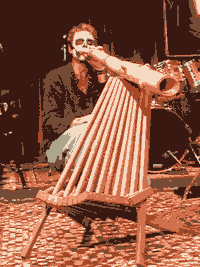Didgeridoo
Like
many traditional instruments,
the Didgeridoo can be traced back thousands
of years.

Although this is probably the world's oldest wind instrument, the name “Didgeridoo” has been around less than 100 years. The names for these ancient instruments vary, as do the spellings but one of the Aboriginal names for a traditional Didgeridoo is Yidaki. There are many rock art sites in the Northern Territory of Australia that show images of humans playing the Didgeridoo. Archaeological research shows that some of these paintings date back about 2000 years. It is generally believed that the Didgeridoo originally came from the Northern areas of the Northern Territory where these paintings were found.
|
The Didgeridoo still plays a very significant role in the ceremonial lives of the Aboriginal people today. Ceremonies are used to evoke the spirits of the Great Ancestors and to sing ancient songs. These songs tell stories about the time of creation, passing down the knowledge of the “Dreamtime” from generation to generation. While many women currently play the Didgeridoo, it is the men who play at the Aboriginal Dreamtime Ceremonies, while the women dance and sing with them. During ceremonies many Didges are played at once with specific combinations of rhythms and voices for each song. Clap-sticks are hit together to keep time for these hauntingly musical songs. Today, the Didge, as it is commonly referred to, is sometimes played solo in non-traditional contexts.The Didgeridoo is becoming more and more popular in modern music. It has become a staple in dance music played in clubs throughout the world because of it's hypnotic, trance inducing sounds. |